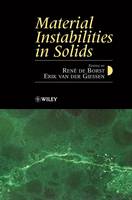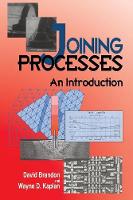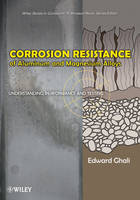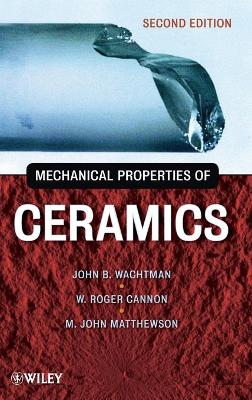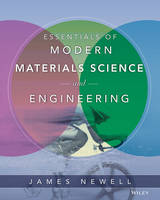Corrosion and Corrosion Control
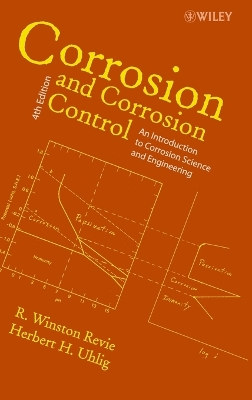 -15%
portes grátis
-15%
portes grátis
Corrosion and Corrosion Control
An Introduction to Corrosion Science and Engineering
Revie, R. Winston
John Wiley & Sons Inc
04/2008
512
Dura
Inglês
9780471732792
15 a 20 dias
886
1 DEFINITION AND IMPORTANCE OF CORROSION 1
1.1 Definition of Corrosion 1
1.1.1 Corrosion Science and Corrosion Engineering 1
1.2 Importance of Corrosion 2
1.3 Risk Management 5
1.4 Causes of Corrosion 6
2 ELECTROCHEMICAL MECHANISMS 9
2.1 The Dry-Cell Analogy and Faraday's Law 9
2.2 Definition of Anode and Cathode 11
2.3 Types of Cells 13
2.4 Types of Corrosion Damage 15
3 THERMODYNAMICS: CORROSION TENDENCY AND ELECTRODE POTENTIALS 21
3.1 Change of Gibbs Free Energy 21
3.2 Measuring the Emf of a Cell 22
3.3 Calculating the Half-Cell Potential-The Nernst Equation 22
3.4 The Hydrogen Electrode and the Standard Hydrogen Scale 24
3.5 Convention of Signs and Calculation of Emf 25
3.6 Measurement of pH 28
3.7 The Oxygen Electrode and Differential Aeration Cell 28
3.8 The Emf and Galvanic Series 30
3.9 Liquid Junction Potentials 33
3.10 Reference Electrodes 34
4 THERMODYNAMICS: POURBAIX DIAGRAMS 43
4.1 Basis of Pourbaix Diagrams 43
4.2 Pourbaix Diagram for Water 44
4.3 Pourbaix Diagram for Iron 45
4.4 Pourbaix Diagram for Aluminum 47
4.5 Pourbaix Diagram for Magnesium 48
4.6 Limitations of Pourbaix Diagrams 49
5 KINETICS: POLARIZATION AND CORROSION RATES 53
5.1 Polarization 53
5.2 The Polarized Cell 54
5.3 How Polarization Is Measured 56
5.4 Causes of Polarization 58
5.5 Hydrogen Overpotential 63
5.6 Polarization Diagrams of Corroding Metals 66
5.7 Influence of Polarization on Corrosion Rate 68
5.8 Calculation of Corrosion Rates from Polarization Data 71
5.9 Anode-Cathode Area Ratio 73
5.10 Electrochemical Impedance Spectroscopy 75
5.11 Theory of Cathodic Protection 77
6 PASSIVITY 83
6.1 Definition 83
6.2 Characteristics of Passivation and the Flade Potential 84
6.3 Behavior of Passivators 88
6.4 Anodic Protection and Transpassivity 90
6.5 Theories of Passivity 92
6.6 Critical Pitting Potential 97
6.7 Critical Pitting Temperature 99
6.8 Passivity of Alloys 100
6.9 Effect of Cathodic Polarization and Catalysis 108
7 IRON AND STEEL 115
7.1 Introduction 115
7.2 Aqueous Environments 116
7.3 Metallurgical Factors 138
7.4 Steel Reinforcements in Concrete 143
8 EFFECT OF STRESS 149
8.1 Cold Working 149
8.2 Stress-Corrosion Cracking 150
8.3 Mechanism of Stress-Corrosion Cracking of Steel and Other Metals 156
8.4 Hydrogen Damage 166
8.5 Radiation Damage 172
8.6 Corrosion Fatigue 173
8.7 Fretting Corrosion 180
9 ATMOSPHERIC CORROSION 191
9.1 Introduction 191
9.2 Types of Atmospheres 192
9.3 Corrosion-Product Films 192
9.4 Factors Infl uencing Corrosivity of the Atmosphere 195
9.5 Remedial Measures 201
10 CORROSION IN SOILS 205
10.1 Introduction 205
10.2 Factors Affecting the Corrosivity of Soils 206
10.3 Bureau of Standards Tests 207
10.4 Stress-Corrosion Cracking 210
10.5 Remedial Measures 211
11 OXIDATION 215
11.1 Introduction 215
11.2 Initial Stages 216
11.3 Thermodynamics of Oxidation: Free Energy-Temperature Diagram 218
11.4 Protective and Nonprotective Scales 218
11.5 Wagner Theory of Oxidation 223
11.6 Oxide Properties and Oxidation 224
11.7 Galvanic Effects and Electrolysis of Oxides 227
11.8 Hot Ash Corrosion 229
11.9 Hot Corrosion 229
11.10 Oxidation of Copper 230
11.11 Oxidation of Iron and Iron Alloys 232
11.12 Life Test for Oxidation-Resistant Wires 233
11.13 Oxidation-Resistant Alloys 234
12 STRAY-CURRENT CORROSION 241
12.1 Introduction 241
12.2 Sources of Stray Currents 242
12.3 Quantitative Damage by Stray Currents 244
12.4 Detection of Stray Currents 245
12.5 Soil-Resistivity Measurement 246
12.6 Means for Reducing Stray-Current Corrosion 246
13 CATHODIC PROTECTION 251
13.1 Introduction 251
13.2 Brief History 252
13.3 How Applied 253
13.4 Combined Use with Coatings 255
13.5 Magnitude of Current Required 257
13.6 Anode Materials and Backfi ll 258
13.7 Criteria of Protection 260
13.8 Economics of Cathodic Protection 263
13.9 Anodic Protection 263
14 METALLIC COATINGS 269
14.1 Methods of Application 269
14.2 Classification of Coatings 271
14.3 Specific Metal Coatings 272
15 INORGANIC COATINGS 285
15.1 Vitreous Enamels 285
15.2 Portland Cement Coatings 286
15.3 Chemical Conversion Coatings 286
16 ORGANIC COATINGS 289
16.1 Introduction 289
16.2 Paints 289
16.3 Requirements for Corrosion Protection 291
16.4 Metal Surface Preparation 293
16.5 Applying Paint Coatings 295
16.6 Filiform Corrosion 296
16.7 Plastic Linings 299
17 INHIBITORS AND PASSIVATORS 303
17.1 Introduction 303
17.2 Passivators 304
17.3 Pickling Inhibitors 310
17.4 Slushing Compounds 313
17.5 Vapor-Phase Inhibitors 313
18 TREATMENT OF WATER AND STEAM SYSTEMS 317
18.1 Deaeration and Deactivation 317
18.2 Hot- and Cold-Water Treatment 321
18.3 Boiler-Water Treatment 323
19 ALLOYING FOR CORROSION RESISTANCE; STAINLESS STEELS 333
19.1 Introduction 333
19.2 Stainless Steels 335
20 COPPER AND COPPER ALLOYS 367
20.1 Copper 367
20.2 Copper Alloys 371
21 ALUMINUM AND ALUMINUM ALLOYS 383
21.1 Aluminum 383
21.2 Aluminum Alloys 393
22 MAGNESIUM AND MAGNESIUM ALLOYS 399
22.1 Introduction 399
22.2 Magnesium 399
22.3 Magnesium Alloys 400
22.4 Summary 404
23 NICKEL AND NICKEL ALLOYS 407
23.1 Introduction 407
23.2 Nickel 408
23.3 Nickel Alloys 411
24 COBALT AND COBALT ALLOYS 419
24.1 Introduction 419
24.2 Cobalt Alloys 420
25 TITANIUM 425
25.1 Titanium 425
25.2 Titanium Alloys 427
25.3 Pitting and Crevice Corrosion 429
25.4 Intergranular Corrosion and Stress-Corrosion Cracking 430
26 ZIRCONIUM 435
26.1 Introduction 435
26.2 Zirconium Alloys 436
26.3 Behavior in Hot Water and Steam 437
27 TANTALUM 441
27.1 Introduction 441
27.2 Corrosion Behavior 441
28 LEAD 445
28.1 Introduction 445
28.2 Corrosion Behavior of Lead and Lead Alloys 446
28.3 Summary 448
29 APPENDIX 451
29.1 Activity and Activity Coeffi cients of Strong Electrolytes 451
29.2 Derivation of Stern-Geary Equation for Calculating Corrosion Rates from Polarization Data Obtained at Low Current Densities 456
29.3 Derivation of Equation Expressing the Saturation Index of a Natural Water 461
29.4 Derivation of Potential Change along a Cathodically Protected Pipeline 467
29.5 Derivation of the Equation for Potential Drop along the Soil Surface Created by Current Entering or Leaving a Buried Pipe 469
29.6 Derivation of the Equation for Determining Resistivity of Soil by Four-Electrode Method 470
29.7 Derivation of the Equation Expressing Weight Loss by Fretting Corrosion 471
29.8 Conversion Factors 474
29.9 Standard Potentials 476
29.10 Notation and Abbreviations 476
References 478
Index 479
1 DEFINITION AND IMPORTANCE OF CORROSION 1
1.1 Definition of Corrosion 1
1.1.1 Corrosion Science and Corrosion Engineering 1
1.2 Importance of Corrosion 2
1.3 Risk Management 5
1.4 Causes of Corrosion 6
2 ELECTROCHEMICAL MECHANISMS 9
2.1 The Dry-Cell Analogy and Faraday's Law 9
2.2 Definition of Anode and Cathode 11
2.3 Types of Cells 13
2.4 Types of Corrosion Damage 15
3 THERMODYNAMICS: CORROSION TENDENCY AND ELECTRODE POTENTIALS 21
3.1 Change of Gibbs Free Energy 21
3.2 Measuring the Emf of a Cell 22
3.3 Calculating the Half-Cell Potential-The Nernst Equation 22
3.4 The Hydrogen Electrode and the Standard Hydrogen Scale 24
3.5 Convention of Signs and Calculation of Emf 25
3.6 Measurement of pH 28
3.7 The Oxygen Electrode and Differential Aeration Cell 28
3.8 The Emf and Galvanic Series 30
3.9 Liquid Junction Potentials 33
3.10 Reference Electrodes 34
4 THERMODYNAMICS: POURBAIX DIAGRAMS 43
4.1 Basis of Pourbaix Diagrams 43
4.2 Pourbaix Diagram for Water 44
4.3 Pourbaix Diagram for Iron 45
4.4 Pourbaix Diagram for Aluminum 47
4.5 Pourbaix Diagram for Magnesium 48
4.6 Limitations of Pourbaix Diagrams 49
5 KINETICS: POLARIZATION AND CORROSION RATES 53
5.1 Polarization 53
5.2 The Polarized Cell 54
5.3 How Polarization Is Measured 56
5.4 Causes of Polarization 58
5.5 Hydrogen Overpotential 63
5.6 Polarization Diagrams of Corroding Metals 66
5.7 Influence of Polarization on Corrosion Rate 68
5.8 Calculation of Corrosion Rates from Polarization Data 71
5.9 Anode-Cathode Area Ratio 73
5.10 Electrochemical Impedance Spectroscopy 75
5.11 Theory of Cathodic Protection 77
6 PASSIVITY 83
6.1 Definition 83
6.2 Characteristics of Passivation and the Flade Potential 84
6.3 Behavior of Passivators 88
6.4 Anodic Protection and Transpassivity 90
6.5 Theories of Passivity 92
6.6 Critical Pitting Potential 97
6.7 Critical Pitting Temperature 99
6.8 Passivity of Alloys 100
6.9 Effect of Cathodic Polarization and Catalysis 108
7 IRON AND STEEL 115
7.1 Introduction 115
7.2 Aqueous Environments 116
7.3 Metallurgical Factors 138
7.4 Steel Reinforcements in Concrete 143
8 EFFECT OF STRESS 149
8.1 Cold Working 149
8.2 Stress-Corrosion Cracking 150
8.3 Mechanism of Stress-Corrosion Cracking of Steel and Other Metals 156
8.4 Hydrogen Damage 166
8.5 Radiation Damage 172
8.6 Corrosion Fatigue 173
8.7 Fretting Corrosion 180
9 ATMOSPHERIC CORROSION 191
9.1 Introduction 191
9.2 Types of Atmospheres 192
9.3 Corrosion-Product Films 192
9.4 Factors Infl uencing Corrosivity of the Atmosphere 195
9.5 Remedial Measures 201
10 CORROSION IN SOILS 205
10.1 Introduction 205
10.2 Factors Affecting the Corrosivity of Soils 206
10.3 Bureau of Standards Tests 207
10.4 Stress-Corrosion Cracking 210
10.5 Remedial Measures 211
11 OXIDATION 215
11.1 Introduction 215
11.2 Initial Stages 216
11.3 Thermodynamics of Oxidation: Free Energy-Temperature Diagram 218
11.4 Protective and Nonprotective Scales 218
11.5 Wagner Theory of Oxidation 223
11.6 Oxide Properties and Oxidation 224
11.7 Galvanic Effects and Electrolysis of Oxides 227
11.8 Hot Ash Corrosion 229
11.9 Hot Corrosion 229
11.10 Oxidation of Copper 230
11.11 Oxidation of Iron and Iron Alloys 232
11.12 Life Test for Oxidation-Resistant Wires 233
11.13 Oxidation-Resistant Alloys 234
12 STRAY-CURRENT CORROSION 241
12.1 Introduction 241
12.2 Sources of Stray Currents 242
12.3 Quantitative Damage by Stray Currents 244
12.4 Detection of Stray Currents 245
12.5 Soil-Resistivity Measurement 246
12.6 Means for Reducing Stray-Current Corrosion 246
13 CATHODIC PROTECTION 251
13.1 Introduction 251
13.2 Brief History 252
13.3 How Applied 253
13.4 Combined Use with Coatings 255
13.5 Magnitude of Current Required 257
13.6 Anode Materials and Backfi ll 258
13.7 Criteria of Protection 260
13.8 Economics of Cathodic Protection 263
13.9 Anodic Protection 263
14 METALLIC COATINGS 269
14.1 Methods of Application 269
14.2 Classification of Coatings 271
14.3 Specific Metal Coatings 272
15 INORGANIC COATINGS 285
15.1 Vitreous Enamels 285
15.2 Portland Cement Coatings 286
15.3 Chemical Conversion Coatings 286
16 ORGANIC COATINGS 289
16.1 Introduction 289
16.2 Paints 289
16.3 Requirements for Corrosion Protection 291
16.4 Metal Surface Preparation 293
16.5 Applying Paint Coatings 295
16.6 Filiform Corrosion 296
16.7 Plastic Linings 299
17 INHIBITORS AND PASSIVATORS 303
17.1 Introduction 303
17.2 Passivators 304
17.3 Pickling Inhibitors 310
17.4 Slushing Compounds 313
17.5 Vapor-Phase Inhibitors 313
18 TREATMENT OF WATER AND STEAM SYSTEMS 317
18.1 Deaeration and Deactivation 317
18.2 Hot- and Cold-Water Treatment 321
18.3 Boiler-Water Treatment 323
19 ALLOYING FOR CORROSION RESISTANCE; STAINLESS STEELS 333
19.1 Introduction 333
19.2 Stainless Steels 335
20 COPPER AND COPPER ALLOYS 367
20.1 Copper 367
20.2 Copper Alloys 371
21 ALUMINUM AND ALUMINUM ALLOYS 383
21.1 Aluminum 383
21.2 Aluminum Alloys 393
22 MAGNESIUM AND MAGNESIUM ALLOYS 399
22.1 Introduction 399
22.2 Magnesium 399
22.3 Magnesium Alloys 400
22.4 Summary 404
23 NICKEL AND NICKEL ALLOYS 407
23.1 Introduction 407
23.2 Nickel 408
23.3 Nickel Alloys 411
24 COBALT AND COBALT ALLOYS 419
24.1 Introduction 419
24.2 Cobalt Alloys 420
25 TITANIUM 425
25.1 Titanium 425
25.2 Titanium Alloys 427
25.3 Pitting and Crevice Corrosion 429
25.4 Intergranular Corrosion and Stress-Corrosion Cracking 430
26 ZIRCONIUM 435
26.1 Introduction 435
26.2 Zirconium Alloys 436
26.3 Behavior in Hot Water and Steam 437
27 TANTALUM 441
27.1 Introduction 441
27.2 Corrosion Behavior 441
28 LEAD 445
28.1 Introduction 445
28.2 Corrosion Behavior of Lead and Lead Alloys 446
28.3 Summary 448
29 APPENDIX 451
29.1 Activity and Activity Coeffi cients of Strong Electrolytes 451
29.2 Derivation of Stern-Geary Equation for Calculating Corrosion Rates from Polarization Data Obtained at Low Current Densities 456
29.3 Derivation of Equation Expressing the Saturation Index of a Natural Water 461
29.4 Derivation of Potential Change along a Cathodically Protected Pipeline 467
29.5 Derivation of the Equation for Potential Drop along the Soil Surface Created by Current Entering or Leaving a Buried Pipe 469
29.6 Derivation of the Equation for Determining Resistivity of Soil by Four-Electrode Method 470
29.7 Derivation of the Equation Expressing Weight Loss by Fretting Corrosion 471
29.8 Conversion Factors 474
29.9 Standard Potentials 476
29.10 Notation and Abbreviations 476
References 478
Index 479






